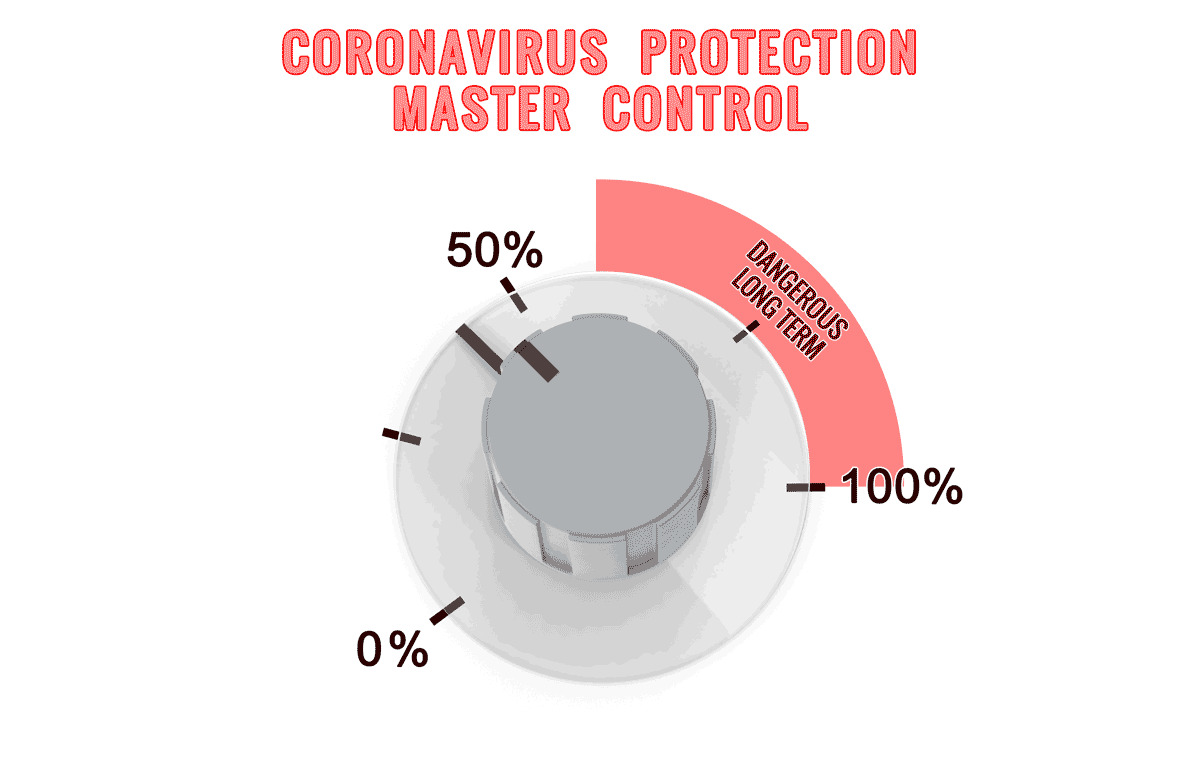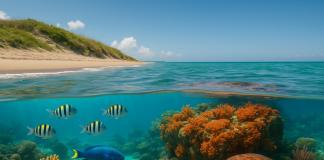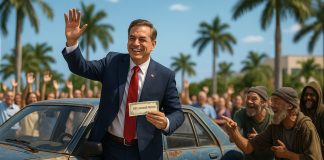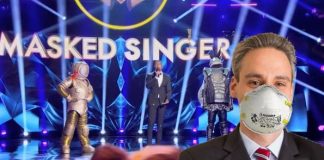There’s a thought exercise we can play with, a way to think about protecting ourselves from coronavirus. This thought exercise allows us to ask ourselves some critical questions that are now being overlooked. How far should we go to protect ourselves from coronavirus, given all the steps we can take? How much is too little? How much is too much? Where does a prudent level of protection end and the oversteer into exacerbating our problems begin?
A “MASTER CONTROL for Protection from Coronavirus”: A Dial That Can be Turned from Zero to One Hundred Percent
Imagine, if you will, a “master control knob” that has some kind over magic omnipotent way to determine how much a community can to protect themselves. Think of some plastic knob that can be turned from a setting marked 0% all the way to a setting marked 100%. If you had some kind of control panel you could use to change the settings for how a community behaves and operates, this is just one of the dials that you could imagine being there.
The Setting Controls the Degree of Protection: The Relative Amount of Lives Saved
At zero percent the community is doing nothing about protecting themselves – they’re completely unaware of the danger. At 100 percent the community is doing absolutely everything possible they all can to educate each other, monitor the cases, and prevent the spread of the virus.
Let’s also imagine, for simplicity sake in this thought exercise, that setting the knob at zero meant nobody was saved by any protection in the community. At a zero percent setting our master control knob for coronavirus would result in the maximum number of deaths the virus could potentially cause. Likewise at 100% the master control for coronavirus would prevent all deaths, and nobody dies from the virus.
The Setting Also Directly Impacts the Cost of Protecting the Community
Imagine also that turning up the knob siphons energy and potential from the other things going on in the community – namely commerce, education, self-improvement and socialization. If the knob is turned all the way to 100% percent almost all of those things stop, except for the bare essentials, and the maximum of the whole of the community’s time and resources go into protecting themselves from coronavirus. 100% protection means 100% cost. 100% protection means everyone stays in their homes in different rooms and just waits unless they’re “essentials”.
Now let’s just ask these two simple questions:
- How far did we turn the knob, protecting ourselves from coronavirus by simply closing the schools?
Was it 20%? Was it 50%? Was it 90%? - Given what we know about the ability of the healthcare system to respond to coronavirus now, what would the correct setting have been for that master control dial? Could we have afforded to leave it alone and let the pandemic complete itself in once brief, but harder to deal with peak? Could we have afforded not to closed schools, or change how schools work without closing them altogether?
These are critical questions to answer!
As a degree holding, practiced microbiologist and a parent who has experienced raising two kids in South Florida here’s what I think:
- I think we turned the dial past 75% when we closed down the schools. Kids, in schools, are the #1 way that viruses get a free ride into families and around the population of South Florida.
- I think that, given the overwhelming contribution of schools to the movement of viruses, that when we closed schools we did more than enough, at least as far as South Florida is concerned. The actions taken closing down hotels, resorts, beaches, golf courses, swimming pools, sit-down service in restaurants and City Hall were, in hindsight, unnecessary for meeting the primary goal of restrictions: keeping hospital beds from filling up.
Here’s why I think that we overreacted.
Students and educators make up one fifth of our population. Illnesses spread inside schools are responsible for hundreds of South Florida deaths per week. Kids, especially elementary school and pre-school kids, do not have strongly developed immune systems and the constitutions of middle schoolers and teens, so they’re particularly vulnerable to being infected. When we shut down schools we stopped over 90% of virus potential for transmission among the non-healthcare worker population OR MORE. There’s no other phenomenon in the community where everyone from almost every segment of the population mixes together and shares so many “used” facilities for such a long amount of time each day compared to schools. Each door knob gets touched many times a day. Each water fountain gets used many times a day. Kids are fit together tightly, in groups, simply to listen and learn. Then on top of that you’ve got sports that involve daily sweaty contact like basketball, football and wrestling. A school is virus heaven.
So I strongly believe the “dial” is turned way past 50% at a minimum by closing schools. If you can convince me there’s some other place where viruses have such an easy time moving around, please let me know.
I think closing the schools turned the dial so that 75% of the virus transmission rate was squelched. The result of that was that hospitals took in only 1/4 of the patients they’d otherwise see from coronavirus. This was good. This was what we wanted. We wanted to slow down that rate – and we did, in theory.
What did we see happen in reality? We can’t really say what the rate would have been had we not closed the schools. We’ll never really know. Did the healthcare system in metropolitan South Florida have, in hindsight, the ability to absorb a higher rate of patients? Yes. Our healthcare system in even the most impacted places in South Florida was always far from being overwhelmed.
By turning that “Master Control for Protection from Coronavirus” to 75%, by closing the schools, we did more than enough to stop the spread to a manageable rate, a rate our heathcare system kept up with.
Let’s imagine that we slowed the rate of patients requiring critical care into hospitals by 75%. Instead of a hundred patients in a hospital we instead saw 25. Those other 75 patients will show up in the following weeks, spread out now, at a rate where no more than 25 patients are in the hospital at a time. This was our success, collectively, by our dial being turned to 75%, closing the schools, and all the behaviors we engaged in.
But what about the cost of turning it that much? Did we stop there with schools? Did someone ask if turning the dial that much was more than enough? At the time when we closed the schools we didn’t know. We didn’t know enough about the virus. We had no local numbers to work from, only information from overseas that was often inconsistent.
We didn’t stop there at just closing schools. We kept turning it because we were scared. We went past 75% and turned the thing way up over the 90% range. We closed down restaurants with the sad exception of take-out and delivery. We’ve closed “non-essential” retail establishments. We closed gyms. We’ve made large companies in the exercise industry lay off hundreds of workers locally. We turned that dial so hard it really really hurt substantially. It hurt people. Things we had before won’t be there any more. Our turning the dial that far killed them. We were so afraid of the unknown we just turned it as far as we could and still have dinner.
Was closing schools “enough” to achieve the effect we were after, the slowing of the rate of the spread of coronavirus so it could be managed effectively by our healthcare system so lack of care didn’t increase deaths?
Yes, absolutely we did. We achieved that goal.
We never had the unobtainable goal of preventing every death, or ultimately preventing the spread of the novel coronavirus. We never closed schools or demanded testing because H1N1 was actually killing kids. This virus could be a big killer like H1N1 over time or it could be a dud and like a weaker strain of influenza. What we can be certain of is that Nature designed it to spread. Just like we failed at doing with H1N1 and tuberculosis, it may never be possible to prevent coronavirus completely. An effort with the goal of complete eradication may be futile.
We cannot afford to turn the dial of our Master Control for Protection from Coronavirus so high as “saving every life possible” implies. We can never stop the spread completely. Turning it as high as we did to stop schools isn’t a setting we can tolerate long term. We cannot keep kids out of school forever. It’s the level of setting that we can turn the knob to, temporarily, but only for as long as it takes us to get ourselves readied to turn it back down again. Imagine the “sweet spot,” where our degree of investment maximizes the return we get for it, at 50%. If we keep it above 50% for too long we’re costing “lives” in other ways for the purpose of saving lives from coronavirus.
We can’t ignore the dial and let go of it. It would fall back to zero if we let go and neglected it and lives would be lost from neglect, But we can’t afford to keep intense efforts sustained for long. We need to balance our fear of the unknowns against the real degree to which it costs us, holistically and long-term, in terms of lives by the negative impact on commerce, education, self-improvement and socialization.
I think we did more than enough by closing schools. We did enough to allow the healthcare system to keep up. This was always the primary goal.
Closing businesses too was probably overkill at the time and is definitely overkill now. Instead of diminishing harm the overly-excessive response that’s drifted from its initial goals is exacerbating harm.
I think we should get back to work, everyone, and see this and a teachable, valuable drill. We should breathe a sigh of relief that our new microbial neighbor isn’t as bad as he could be, as bad as the housemate he moved in with that has been your neighbor since 2009: H1N1, a pathogen that already was taking 300 Floridian lives a week before coronavirus took it’s first victim. This new neighbor might be a true jerk, taking lives, but at least we know he’s not going to turn into a werewolf and go on an unmanageable rampage like what we are shown happened in NYC. We’ve already been past the full moon and our new neighbor in Florida never transformed into the wolfman here. It might be scary, but we moved to a state that’s a jungle with alligators, surrounded by sharks, visited by hurricanes annually. For us in Florida it’s a bad thing, but it’s not the scariest thing around these parts now that we’ve seen its colors.
Maybe you don’t feel this way?
Maybe you think the dial was turned to a different value, a lower value when we closed schools?
Maybe you feel like we aren’t protecting enough lives at the moment and there’s more things we need to be doing now?
Maybe you feel like we need to be testing everyone, just to know something novel we never knew about any virus before, what the true value for infection in the population is?
Please engage with me in the comments below. Your opinion matters.












Good essay.
Thank you